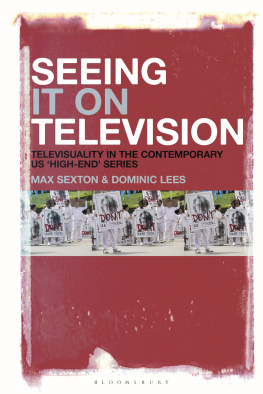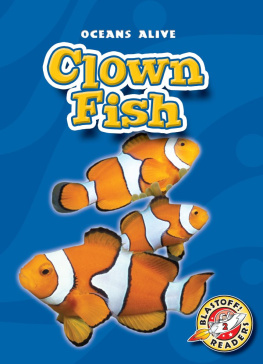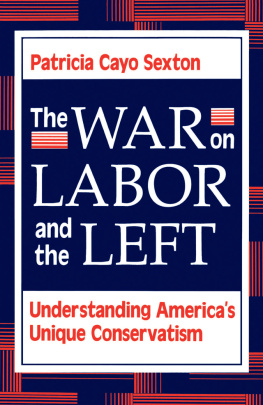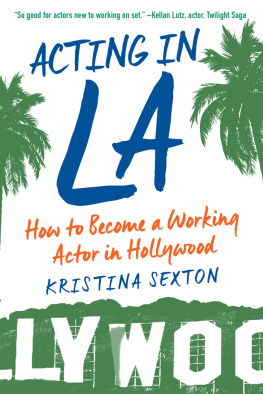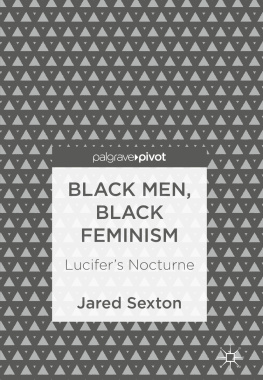Max Sexton - Seeing It on Television: Televisuality in the Contemporary US ‘High-End’ Series
Here you can read online Max Sexton - Seeing It on Television: Televisuality in the Contemporary US ‘High-End’ Series full text of the book (entire story) in english for free. Download pdf and epub, get meaning, cover and reviews about this ebook. year: 2021, publisher: Bloomsbury Academic, genre: Children. Description of the work, (preface) as well as reviews are available. Best literature library LitArk.com created for fans of good reading and offers a wide selection of genres:
Romance novel
Science fiction
Adventure
Detective
Science
History
Home and family
Prose
Art
Politics
Computer
Non-fiction
Religion
Business
Children
Humor
Choose a favorite category and find really read worthwhile books. Enjoy immersion in the world of imagination, feel the emotions of the characters or learn something new for yourself, make an fascinating discovery.
- Book:Seeing It on Television: Televisuality in the Contemporary US ‘High-End’ Series
- Author:
- Publisher:Bloomsbury Academic
- Genre:
- Year:2021
- Rating:3 / 5
- Favourites:Add to favourites
- Your mark:
- 60
- 1
- 2
- 3
- 4
- 5
Seeing It on Television: Televisuality in the Contemporary US ‘High-End’ Series: summary, description and annotation
We offer to read an annotation, description, summary or preface (depends on what the author of the book "Seeing It on Television: Televisuality in the Contemporary US ‘High-End’ Series" wrote himself). If you haven't found the necessary information about the book — write in the comments, we will try to find it.
Max Sexton: author's other books
Who wrote Seeing It on Television: Televisuality in the Contemporary US ‘High-End’ Series? Find out the surname, the name of the author of the book and a list of all author's works by series.
Seeing It on Television: Televisuality in the Contemporary US ‘High-End’ Series — read online for free the complete book (whole text) full work
Below is the text of the book, divided by pages. System saving the place of the last page read, allows you to conveniently read the book "Seeing It on Television: Televisuality in the Contemporary US ‘High-End’ Series" online for free, without having to search again every time where you left off. Put a bookmark, and you can go to the page where you finished reading at any time.
Font size:
Interval:
Bookmark:

Seeing It on Television
Seeing It on Television
Televisuality in the Contemporary US High-End Series
Max Sexton and Dominic Lees

Contents
We would like to thank Alison Smith, Holly Neko, Annelies Lovell and Theodore Lees for their support; the Sewing Circle at the University of Reading, led by Doug Pye and John Gibbs, for rigorous analysis; University Centre, Farnborough; and Bernhard Gross at the University of the West of England for their help in completing this book.
Seeing It on Television: Televisuality in the Contemporary US High-End Series is about the theorizing of aesthetics in contemporary US television drama. It examines a range of cultural, technological and formal practices that continue to maintain a distinctive dramatic mode in the high-end series, which acknowledges both televisions history and a high degree of variability in its use of recent televisual conventions.
Television specificity
A discussion of style in television drama presents certain initial problems. How style has been defined historically suggests televisions aesthetics have been mandated by its specificity. For example, in an earlier era, theorists acknowledged the impact on televisions aesthetics of the mediums technological foundations and modes of distribution, including its smaller screen size. This book argues that distinct cultural systems in television continue to promote the study of Televisuality by referring to various discourses around technology and formal practices, as well as types of engagement with style in high-end television.
Televisions dramatic stylistics have always been part of a wider cultural process of shaping aesthetic form. From the 1970s, the cable era of television not only altered the consensus about American political and social values but also supported a number of stylistic innovations, maturing by the 1980s and 1990s into an era of talented producers such as Steven Bochco, Chris Carter, Mark Frost and David Lynch. Now, as shows like Hill Street Blues, X-Files and Twin Peaks recede into the past, television theory acknowledges that a discussion about contemporary shows further demonstrates the need to move beyond fixed categories of style. Instead, the blurring of generic boundaries and the use of intertextuality create a complex understanding of style and cultural worth. John T. Caldwell and Greg M. Smith discuss how aesthetics in television drama have constructed discourses in older shows like Miami Vice (198490) or Ally McBeal (19972002) to achieve a special event status, Increasingly, US television drama has permitted greater stylistic development with complex visual and aural strategies than those which governed it in the past. Meanwhile, to meet the challenge of distinguishing one era of television production from another, a methodology of historical poetics has appeared in Jeremy Butlers Television Style (2010), Jason Mittells Complex TV: The Poetics of Contemporary Television Storytelling (2015) and Trisha Dunleavys Complex Serial Drama and Multiplatform Television (2018). Each of these books deals with debates on television specificity amid distinct historic production contexts.
Seeing It on Television is, therefore, an account of the changing use of style in US drama during the second decade of the twenty-first century. If media convergence threatens older paradigms about the specificity of television drama, it should be recalled that producers have always exploited the tensions between different aesthetic systems, while allowing television to be distinguished from other mediums like film. This book addresses the need to take a broader view of the possibilities of style in recent US drama without ignoring the continued challenges to television specificity, including the claim of the high-end series becoming cinematic.
High-end television serial drama
During the second decade of the twenty-first century, the continuing development of a high-end aesthetic in US television depended on a complex set of industrial and cultural circumstances. To examine this, Seeing It on Television utilizes eight case studies in order to develop a sense of what can be defined as high-end television drama. Since the 1990s, high-end television has been applied to a type of serial drama whose structure of narrative deferral has been increasingly sought by media conglomerates.
Prior to digitalization, television drama could be characterized by what have been termed by Marie-Laure Ryan as semiotic affordances of the medium. Nevertheless, the value, scope and meaning of formalist definitions of high-end drama must be considered in a cultural context, as much as an economic or technical one.
Televisions distinct forms suggest notions of worth about types of high-quality drama that are predicated less on technical quality the choice of camera and so on than its cultural significance as a creative medium. In this way, high-end drama is a term that is flexible enough to include a plurality of styles, albeit remaining distinct from mainstream practices. This book deals with some of the problems of how high-end television has maintained its distinctiveness in recent years. Often boundaries between high-end television and mainstream practices depend on concepts to do with original content. Ultimately, this defines high-end drama as an aspirational idea of television. Chapters in this book examine how style in high-end television, as both a concept and a practice, reveal how it can be understood in terms of cultural, as well as economic, value.
The central claim in Seeing It on Television is that selected programmes possess distinctiveness within a discourse of original content allied to authorship. However, this book is careful not to devise a hierarchy or set of aestheticist ideas that operates as a dramatic mode. Rather than argue that a high-end series comes from one persons vision, there is, for example, a dialectic between the role of the showrunner or director as the guarantor of quality and a production aligned with the cultural shift to the audience. In fact, what is usually striking within the shows discussed in this book is a pluralization of televisual style across a serial narrative as its ongoing story world demands engagement by its audience. One consequence has been that a distinctive style is more robust than ever in high-end drama. However, by expanding the scope in television drama, style can become diffuse precisely because it draws upon a narrative mode, sometimes spanning many weeks. This complicates ideas about a unifying authorship by the showrunner. Rather, it acknowledges a greater engagement of the audience due to the capacity of serial drama to nurture loyal viewers, as well as its ability to provide a range of other pleasures, including the play between dramatic modes and generic codes over multiple episodes.
Televisuality
This book, therefore, attempts to do two things. The first is to understand style through its various discourses. Chapter 1 draws upon a historical approach to television that is similar to Nol Carrolls critique of cinema, seeking to find the historical tools for identifying the conditions for the production of types of film. Discourses about textual complexity and original content are explored in Chapter 1 to make sense of the initial stylistic features in the TV shows that follow. To this extent, high-end television is to be understood as practices that are highly variable, although they continue to be specific to a single medium. The second objective is to deploy a closer reading of style than is usual in television studies. Although various discourses are useful when discussing, for example, ideas about televisions legitimate style and cultural value, a reading of televisions poetics further articulates wider issues about authorship. The complex processes of authorship and the decisions taken by showrunners, directors and performers demonstrate the importance of considering the style elements of high-end drama. In the eight shows of this book, the creation of modalities and the signification of textual meanings allied to authorship start to demonstrate the greater variability of high-end television, while maintaining a distinctive televisual praxis, including its interaction with film.
Font size:
Interval:
Bookmark:
Similar books «Seeing It on Television: Televisuality in the Contemporary US ‘High-End’ Series»
Look at similar books to Seeing It on Television: Televisuality in the Contemporary US ‘High-End’ Series. We have selected literature similar in name and meaning in the hope of providing readers with more options to find new, interesting, not yet read works.
Discussion, reviews of the book Seeing It on Television: Televisuality in the Contemporary US ‘High-End’ Series and just readers' own opinions. Leave your comments, write what you think about the work, its meaning or the main characters. Specify what exactly you liked and what you didn't like, and why you think so.

